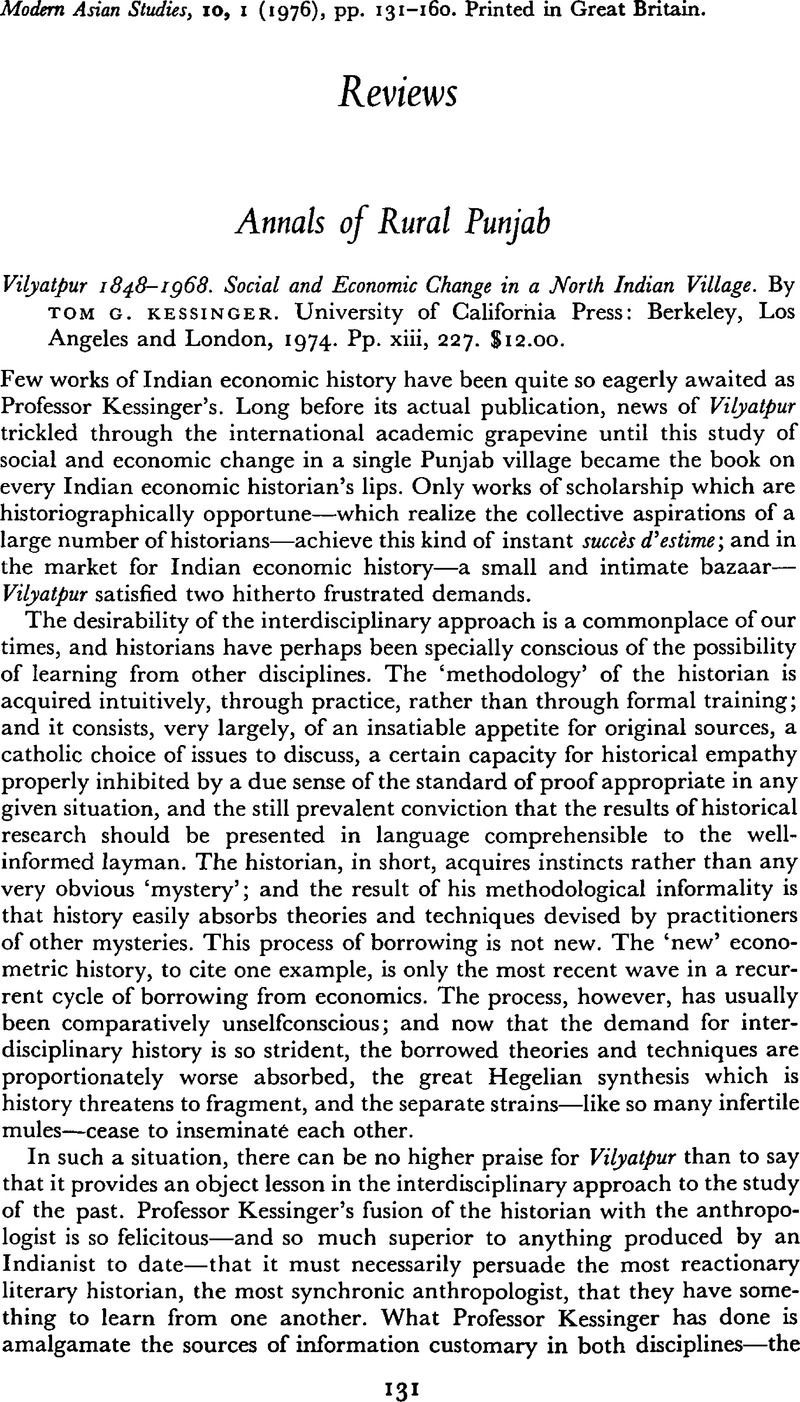No CrossRef data available.
Article contents
Annals of Rural Punjab - Vilyatpur 1848–1968. Social and Economic Change in a North Indian Village. By Tom G. Kessinger. University of California Press: Berkeley, Los Angeles and London, 1974. Pp. xiii, 227. $12.00.
Published online by Cambridge University Press: 28 November 2008
Abstract

- Type
- Reviews
- Information
- Copyright
- Copyright © Cambridge University Press 1976
References
1 Dewey, C. J., ‘The Agricultural Statistics of the Punjab, 1867–1947,’ Bulletin of Quantitative and Computer Methods in South Asian Studies, 2 (03 1974), pp. 3–14.Google Scholar
2 ‘The people,’ a Jullundur settlement officer wrote of the district containing Vilyatpur, ‘are accustomed to effect exchanges of land… These changes had not been fully recorded in the Annual Papers, and it was almost impossible to trace them, when, after a lapse of years, they had been obscured by partitions, transfers and fresh exchanges.’ Purser, W. E., Final Report on the Revised Settlement of the Jullundur District (Lahore, 1892), p. 180.Google Scholar Cf. Singh, Bhai Hotu, Final Report on the Second Revised Settlement (1913–1917) of the Jullundur District (Lahore, 1918), p. 20.Google Scholar
3 See Punjab Government Revenue File 190 (Archives of the Punjab Board of Revenue, Lahore). The most impressive of these special inquiries was Thorburn's, S. S.Report on Peasant Indebtedness and Land Alienation to Moneylenders in Parts of the Rawalpindi Division, 2 vols. (Lahore, 1896: confidential).Google Scholar
4 ‘As elsewhere,’ Purser complained, ‘so here it was found that the Patwaris had learnt nothing… (They) did not want to work. In one tahsil they all suggested they should be allowed to provide substitutes at their own cost and go to their homes till the settlement was completed. The supervising staff did not approve of working with patwaris who had to be taught everything, and much preferred the old system of employing Amins (professional surveyors) who… did not require looking after. No cordial cooperation was to be expected from them.’ Purser, W. E., Final Report, p. 178.Google Scholar Cf. the slightly earlier settlement of Delhi: ‘The details of attestation, if honestly carried out, leave little to be desired in the way of scrupulous and minute attention to accuracy… But I need hardly say it is not so; the Patwari, the Munsarim and the Deputy Superintendent, all alike, are lazy or corrupt, and attestation became a haphazard process in which the minimum of care is taken which may be thought sufficient to escape punishment.’ Maconachie, R., Report on the Revised Settlement of the Delhi District, 1872–80 (Lahore, 1882), pp. 173:–4.Google Scholar Or cf. Karnal: ‘The Patwaris’ annual papers were found to be so incomplete and incorrect that they were quite useless as a preliminary record of holdings.… being often little more than copies made from year to year… In an immense number of cases of inheritance the death had never been reported, nor mutation of names effected.’ Ibbetson, D. C. J., Report on the Settlement of Panipat Tahsil and Karnal Parganah, Karnal District, 1872–80 (Allahabad, 1883), pp. 246, 248.Google Scholar
5 Such an examination is attempted in Dewey, C. J., ‘Agricultural Statistics’.Google Scholar
6 As an example of high-level revenue records which might have been of use to Professor Kessinger, I would cite the (unpublished) assessment reports written in the course of each settlement, and more especially those written by Bhai Hotu Singh, whose published settlement report is too brief to be of much interest.
7 The kind of entrée to agrarian society conferred by the higher-level revenue records is well illustrated by Charlesworth's, N. G.Cambridge Ph.D. thesis (1974);Google ScholarMusgrave's, P. J. ‘Landlords and Lords of the Land: Estate Management and Social Control in Uttar Pradesh, 1860–1920,’ Modern Asian Studies, 6 (1972), pp. 257–75;CrossRefGoogle Scholar or the papers by Musgrave, Washbrook and Baker originally delivered at seminars at the Institute of Commonwealth Studies, University of London, and shortly to be published as parts of a symposium on Indian and African economic history by Athlone Press.




